#Genkō-an Temple
Text
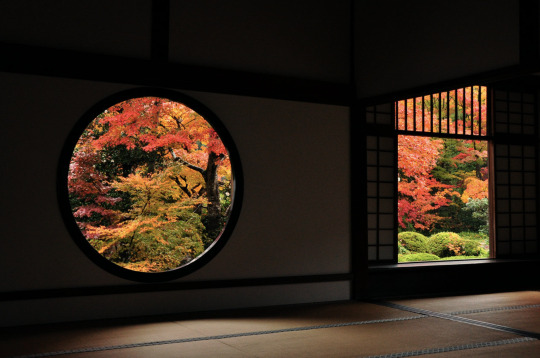
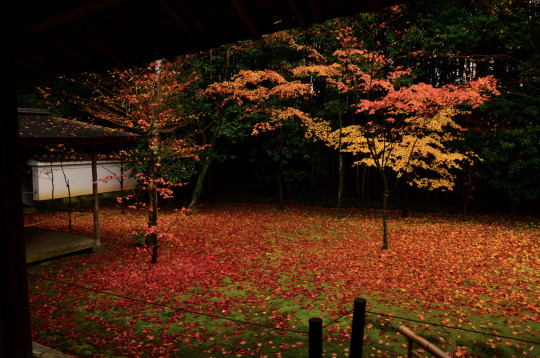
Genkō-an Temple by 鈴電
#Genkō-an Temple#nature#photography#fall autumn#temple#japan#kyoto#orange#trees#red#green#plants#windows#circle window#yellow#fall colors#autumn leaves#1k
4K notes
·
View notes
Photo

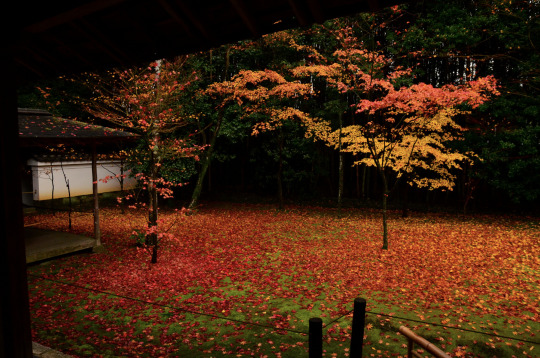
Genko-an Temple, Kyoto, Japan | 鈴電
From within, the eye is drawn to the outside and the elevated wooden flooring engawa offers a place to enjoy the karesansui-style Japanese garden. The temple's most renowned views on Japanese maple trees are framed by two traditional windows of characteristic geometrical shapes, intended to favour meditation in order to gain true wisdom:
The round window, called Satori no Mado, is the "Window of Enlightenment," and refers to the final Zen state reached by the Buddhas, the circle symbolising the universe; and,
Its counterpart the squared window, called Mayoi no Mado, the "Window of Delusion," that is to say the hardships of the human life: birth, aging, sickness, and death.
#Japan#Genko-an Temple#Kyoto#Soto Zen#Genkoan Temple#Buddhist Temple#Zen Buddhism#Autumn#Genkō-an#Nippon
49 notes
·
View notes
Note
I wasn't asking for Chouki last time, but you know it IS a good idea, so gimme Chokey Dokey Literature Club (Cheaky Breaky Heart?)
This isn't related to Chouki but I just thought you'd like to know that that's the first nickname(?) you gave that really made me do a double-take, conjures up an indescribable feeling it does.
In any case, we can certainly talk about Chouki:

The New Emperor Amidst the Heat Haze — Taira no Chouki
Chouki's Story
A good chunk of Chouki's story takes part alongside Fumikado', and a good part of their character revolves around them as well, I'll be a lot briefer in this one, so go check out Fumikado's post if you want more context as to the why some of this stuff happens.
Chouki's Origins
Unlike Fumikado's origins, which are written in their profile from an omniscient narrator's view, what we have on Chouki's origins apparently come from Taira no Iwakado, who is frankly a rather fishy character. So we might need to take it with a grain of salt.
According to Iwakado, Chouki was born to a branch family of the Mugenri Taira. Much like Fumikado, they used to live in the imperial capital Devanagara with their own parents.
However, Chouki's parents would pass away in a political dispute (likely the same one that orphaned Fumikado), leaving Iwakado to take them in.
Iwakado raised Chouki to be Fumikado's servant, telling them to "always obey Fumikado, be by their side and aid them". That was their entire existence.
The Saeda
To that end, Chouki volunteered to play the magical Saeda flute in order to gather the souls needed for the revival plot. However, the flute could only be played by a "being closer to death", so they resolved to take their own life and become a ghost.
So Chouki made a deal with the master of the Spirit World in order to go against the world's natural order and remain the in the world of the living as a ghost.
However, the master played a nasty trick on them, taking their legs and breath from them when returning them to the living world. This left them incapable of playing the flute, and not long after, Fumikado cut them off from the plan.
Revenge
What Fumikado's intentions were, only they know, but Chouki felt betrayed, like they were tossed aside once they became useless. This feeling turned into hatred, and then a desire for vengeance.
In order to take down Fumikado, they trained under Garaiiya Ogata, Kaisen Azuma, Kujiru Kesa, as well as Gariaya's other shikigami, becoming proficient in both youkai arts and swordfighting.
It was when they began to match Fumikado's power that the Dragonfly Castle revealed itself to them, and welcomed them within. Thus they rose to the throne as the New Emperor of the Dragonfly Castle, and the rest is history.
Name: Taira no Chouki
There's not much to go over with Taira (平), but in Chouki (蝶鬼), "chou" (蝶) means "butterfly" and "ki" (鬼) refers to the youkai oni.
Notably, while it rarely takes this meaning in Japanese (not never though), it almost always means "ghost" in Chinese.
Inspiration: Nyozou-ni
Chouki lightly references Taira no Masakado's 3rd daughter, the Buddhist nun Nyozou-ni, whose birth name is lost to history.
The best historical sources we have on her are the Konjaku Monogatarishū (今昔物語集), a collection of various tales written during the late Heian period, and the Genkō Shakusho (元亨釈書), Japan's first Buddhist history text.
Both tell the same general tale, that to punish Masakado's family for his crimes, his 3rd daughter was exiled to live alone next to an Enichi Temple where she eventually died of illness. (There are two likely candidates that Enichi Temple in the texts refer to, but it is unclear which one it is.)
Depicted below: Enichi Temple's main hall.

She then fell to hell but was rescued by the Buddha Jizou and came back to life, after which she converted to Bhuddism and became a nun known as Nyozou-ni (如蔵尼) or Jizou-ni (地蔵尼).
Nyozou-ni's gravestone at the Enichi Temple in Bandai Town, Fukushima Prefecture reads:
"Takiyasha-hime tried to restore [the clan/her position] after Masakado's death, but failed and became a nun"
It's not exactly clear what she is said to have tried to restore, but this is where we get the name "Takiyasha-hime" from, as well as the idea that she tried to change the outcome of Masakado's rebellion in some sense.
Depicted below: Nyozou-ni's gravestone at the Enichi Temple

While Chouki's story doesn't rely on Nyozou-ni that heavily, it's possible that their visit to and return from the Spirit World is based on Nyozou-ni's own death and revival story.
Inspiration: Takiyasha-hime
Chouki is more heavily based on a mythologized version of Nyozou-ni, Takiyasha-hime (滝夜叉姫).
Her mythologization is believed to date back only to the 17th century, in the 1806 yomihon novel series "The Tale of Utou Yasutaka's Loyalty" (善知安方忠義伝) by Santō Kyōden. (Yep this book again lol)
The books are an attempt to combine the Noh play "Utoh" (善知鳥 Auklets) and the Masakado legends, which is notable because one of Chouki's spells, "The Auklet's Cry, and the Response Thereto", actually reference Utoh directly.
In the novels, she is instead initially known as Kisaragi-ni (如月尼). A Buddhist nun who lives on Mount Tsukuba raising her younger half-brother Taira no Yoshikado (平 良門), something the historical Nyozou-ni is also said to have done (although its veracity is unclear).
Depicted below: Kisaragi-ni (left page) and Yoshikado (right page)

After Masakado indeed failed and was executed, a powerful toad spirit that lived on the mountain, Nikushi-sen (肉芝仙), revealed himself to the siblings and told them the truth of their origins.
He taught them both toad magic, convinced them to restart their father's rebellion, and possessed Kisaragi-ni, transforming her into Takiyasha-hime.
Depicted below: Takiyasha-hime in one of the books (left), Nikushisen (as a toad) and Yoshikado (above the toad)

Takiyasha-hime's paring here with Yoshikado may have inspired Chouki's initial collaboration with Fumikado, while their learning magic from Nikushi-sen may be inspired Chouki's later training with Garaiya, Kaisen, Kujiru and co.
At the climax of the story, Ooya Tarou Mitsukuni (大宅太郎光圀) was sent to seek out any remnants of Masakado's rebellion, and tracked them all the way to Soma's old imperial palace (相馬の古内裏), an old palace modeled after the Emperor's that used to be Masakado's base of operations, where the siblings have been recruiting people still loyal to Masakado's cause.
In a desperate attempt to fight back, the siblings summon and control an army of skeletons to fight back against Mitsukuni and his men but ultimately lose.
Depicted below: Ooya Tarou Mitsukuni fighting off the skeletons.

The end of the story is unknown as the series was never completed, although one could assume that Takiyasha-hime will eventually go to Enichi Temple and become a nun there, reconciling this tale with history.
So that's the general story of Takiyasha-hime in the myths: Masakado's daughter awakens to magic and becomes Takiyasha-hime, hides out at Soma's old imperial palace, summons skeletal monster(s) that Ooya Tarou Mitsukuni defeat.
But the legends would continue to evolve and change, leading to some further references:
Exclusion of Yoshikado and Nikushi-sen
As the Takiyasha-hime myths evolved, she began to be divorced from the characters of Yoshikado and Nikushi-sen, becoming the only central character of the story.
This is potentially referenced in how Chouki would eventually part ways with Fumikado, although I admit I'm not 100% sure about this.
Identification with Masakado's 1st daughter, Satsuki-hime
As the legends evolve, Tskiyasha-hime would sometimes be identified with Masakado's first daughter instead, Satsuki-hime (五月姫 may princess/lady). Here "satsuki" probably is meant to refer to the Rhododendron indicum, and not the actual month of May.
This is referenced in the spell Tearing Card "May Flowering".
Depicted below: A satsuki blossom.
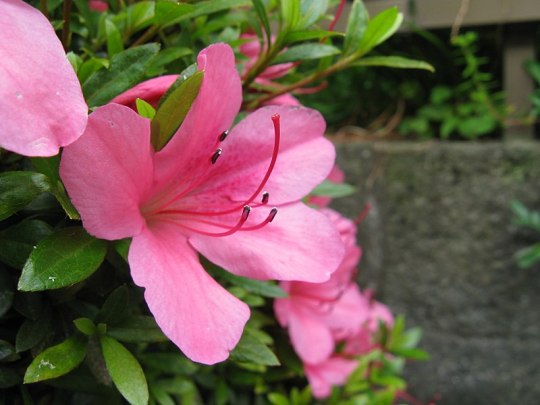
The Ox-hour Shrine Visit
In the tales where Takiyasha-hime was Satsuki-hime, she is often given a very different story regarding her transformation into Tskiyasha-hime.
After Maskado's defeat and subsequent death, all his family and servants were executed as well, but Satsuki-hime somehow survived.
Harbouring extreme hatred for her enemies, she started performing a fearsome curse ritual called the "ox-hour shrine visit" at the Kifune Shrine (貴船神社).
On her 21st night performing the curse, she hears the voice of the rough and violent spirit of the shrine's god, Takaokami-no-Kami, who teachers her sorcery, transforming her into Takiyasha-hime.
This was referenced in the spell "Ox-Hour Visit to Kifune Shrine".
Additionally, this was a popular subject for artists of the time, like in the following woodblock print by Utagawa Toyokuni, which was referenced in Chouki's design as well.

Summoning the Gashadokuro
Based on the climactic scene in the original "The Tale of Utou Yasutaka's Loyalty", Utagawa Kuniyoshi made the woodblock print "Soma's old imperial palace" (相馬の古内裏), where a single giant skeleton is summoned instead of multiple normal-sized ones.
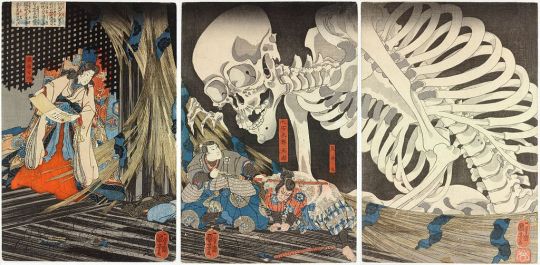
While the gashadokuro is a modern invention from the 1960s, it has been identified with the skeleton in this piece, and the idea that Takiyasha-hime summoned a gashadokuro to fight her enemies was firmly solidified in the public imagination.
This was referenced in the spells Summoning "Gashadokuro" and "Soma's Old Imperial Palace".
And I think that's all! I would say let's look forward to what else they do but they're not showing up in Golden Chapter and almost certainly not MW, so uhh, let's hope BotC at least gives us something more~! :)
12 notes
·
View notes
Photo
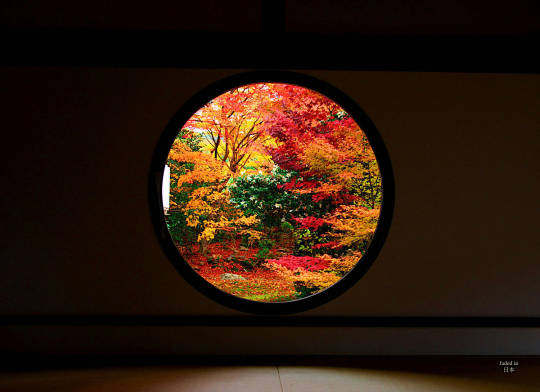
Satori no Mado (悟りの窓) or the Window of Enlightenmentat Genkō-an temple in Kyōto, taken a few years ago on a previous visit to the ancient city that is known as Japan's cultural capital.
152 notes
·
View notes
Text


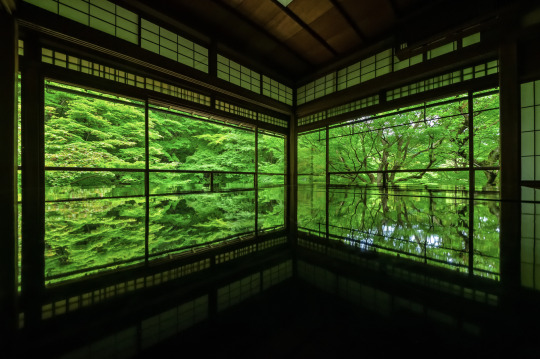
Genkō-an Temple (via)
3K notes
·
View notes